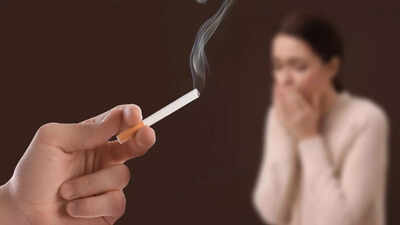ARTICLE AD BOX

You might think that not smoking keeps you safe, but secondhand smoke, which is another name for passive smoking, is not safe at all. The Centers for Disease Control and Prevention (CDC) says that even short exposure to secondhand smoke can hurt the heart and blood vessels right away, which can lead to coronary heart disease and stroke in people who haven’t smoked a day in their lives!The American Lung Association says that this kind of smoke has more than 7,000 chemicals in it.
Many of these chemicals are harmful and can cause cancer.This article talks about how secondhand smoke affects your health, how its risks compare to those of active smoking, and useful ways to keep yourself and your loved ones safe from it all.
What is passive smoking and secondhand smoke
Passive smoking is when someone who doesn't smoke breathes in smoke that someone else is making. This includes smoke that a smoker breathes out and smoke that comes from cigarettes or cigars that are burning.
Most secondhand smoke is made up of sidestream smoke, which often has more harmful chemicals than the smoke that smokers breathe in directly. People who don't smoke are exposed to thousands of harmful chemicals, including more than 70 known carcinogens, in their blood and lungs, even after a short time.
Health effects of passive smoking on the body
Even people who never smoke are affected by secondhand smoke in many ways:
- Heart and blood vessel problems can happen; the risk of heart disease and stroke goes up.
- Causes inflammation and oxidative stress, which then hurts tissues and makes lung and heart diseases more likely.
- Because of carcinogens like benzene, formaldehyde, and polycyclic aromatic hydrocarbons, the risk of getting cancer increases tenfold.
- Making breathing harder and weakening lung defenses, this can cause asthma, bronchitis, and respiratory infections.
Over time, even low levels of exposure can have very, very bad effects on your health.
Passive smoking versus active smoking risks
People who don't smoke inhale less smoke when they are passively smoking than when they are actively smoking. But there are still big risks with it:
- Active smokers take in more air with each puff.
- People who don't smoke get lower doses, but they often smoke for long periods of time, which raises the health risks.
- People who don't smoke are more likely to get lung cancer, heart disease, and breathing problems when they are around smokers.
- Children, women who are pregnant women, and older adults are more likely to get sick from passive smoking.
Health risks of passive smoking and secondhand smoke
People who smoke around others can give them heart disease and stroke.
People who are exposed to secondhand smoke are 20–30% more likely to get heart disease and stroke, even if they themselves do not indulge.
Passive smoking and the risk of lung cancer
People who don't smoke can get lung cancer just from passive smoke.
Problems with breathing caused by passive smoking
Children are more likely to get asthma, bronchitis, pneumonia, and other breathing problems when they are exposed to the toxins released by smoking.
Pregnancy complications from passive smoking
Passive smoking during pregnancy is linked to low birth weight, preterm birth, and developmental issues in babies before they enter the world.
How to protect yourself from passive smoking
- Keep your homes and cars smoke-free: You should never allow indoor smoking in your home or car, even with the windows open.
- Ask the smoker to step outside: Be sure to smoke away from doors and windows, and away from yourself!
- Use ventilators and air purifiers for fresh air; they are helpful but cannot get rid of all the toxins.
- Check your health frequently: If you are frequently exposed to smoke, consider getting lung or cardiovascular function tests as frequently as you can.
- Encourage smoke-free laws: Advocate for bans on smoking in public places, workplaces, and restaurants for the benefit of others' health.
Passive smoking is not at all as harmless as people claim it to be. Even if you are not smoking yourself, exposure to secondhand smoke still increases your risk of getting heart disease, lung cancer, and respiratory illness. Protect yourself and your loved ones by creating smoke-free environments, improving ventilation, raising awareness about secondhand smoke dangers, as well as creating boundaries with people who take your health lightly.
Breathing clean air is one of the easiest and most effective ways to live a long and happy life with your nears and dears. Don’t let it all go up in smoke.Disclaimer: This article is for general informational purposes only and is not a substitute for professional medical advice, diagnosis, or treatment. Always seek the guidance of a qualified healthcare provider regarding any medical condition or lifestyle change.Also read|Keep your bones strong this winter with vitamin D, calcium, and smart habits

 3 hours ago
4
3 hours ago
4









 English (US) ·
English (US) ·